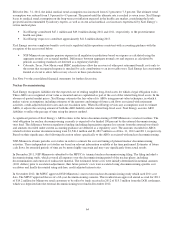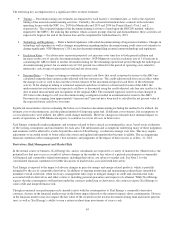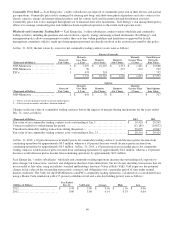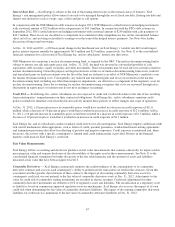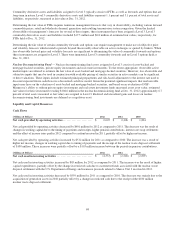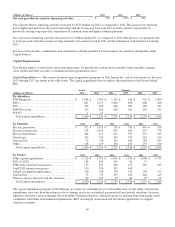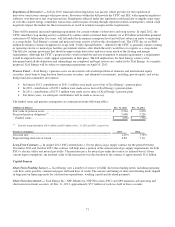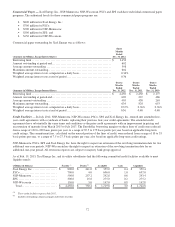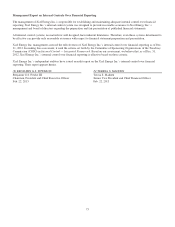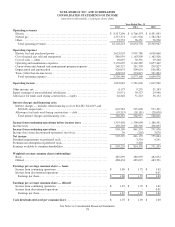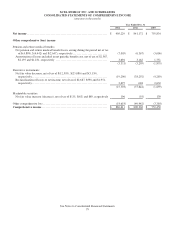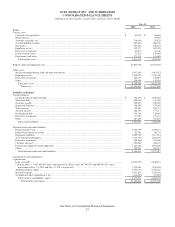Xcel Energy 2012 Annual Report Download - page 83
Download and view the complete annual report
Please find page 83 of the 2012 Xcel Energy annual report below. You can navigate through the pages in the report by either clicking on the pages listed below, or by using the keyword search tool below to find specific information within the annual report.73
Money Pool — Xcel Energy received FERC approval to establish a utility money pool arrangement with the utility subsidiaries,
subject to receipt of required state regulatory approvals. The utility money pool allows for short-term investments in and
borrowings between the utility subsidiaries. Xcel Energy Inc. may make investments in the utility subsidiaries at market-based
interest rates; however, the money pool arrangement does not allow the utility subsidiaries to make investments in Xcel Energy
Inc. The money pool balances are eliminated in consolidation.
NSP-Minnesota, PSCo and SPS participate in the money pool pursuant to approval from their respective state regulatory
commissions. NSP-Wisconsin does not participate in the money pool.
Registration Statements — Xcel Energy Inc.’s Articles of Incorporation authorize the issuance of one billion shares of $2.50 par
value common stock. As of Dec. 31, 2012 and 2011, Xcel Energy Inc. had approximately 488 million shares and 486 million
shares of common stock outstanding, respectively. In addition, Xcel Energy Inc.’s Articles of Incorporation authorize the issuance
of seven million shares of $100 par value preferred stock. Xcel Energy Inc. had no shares of preferred stock outstanding on Dec.
31, 2012 and 2011. Xcel Energy Inc. and its subsidiaries have the following registration statements on file with the SEC, pursuant
to which they may sell, from time to time, securities:
• Xcel Energy Inc. has an effective automatic shelf registration statement filed in August 2012, which does not contain a
limit on issuance capacity. However, Xcel Energy Inc.’s ability to issue securities is limited by authority granted by the
Board of Directors, which currently authorizes the issuance of up to an additional $2.0 billion of debt and common
equity securities.
• NSP-Minnesota has $400 million of debt securities remaining under its currently effective shelf registration statement,
which was filed in July 2012.
• NSP-Wisconsin has $50 million of debt securities remaining under its currently effective shelf registration statement,
which was filed in July 2012.
• PSCo has an automatic shelf registration statement filed in October 2010, which does not contain a limit on issuance
capacity. However, PSCo’s ability to issue securities is limited by authority granted by its Board of Directors, which
currently authorizes the issuance of up to an additional $1.5 billion of debt securities.
• SPS has $50 million of debt securities remaining under its currently effective shelf registration statement, which was
filed in April 2012.
Long-Term Borrowings — See the consolidated statements of capitalization and a discussion of the long-term borrowings in
Note 4 to the consolidated financial statements.
During 2012, Xcel Energy Inc. and its utility subsidiaries completed the following financings:
• In June 2012, SPS issued an additional $100 million of its 4.50 percent first mortgage bonds due Aug. 15, 2041. SPS
used a portion of the net proceeds from the sale of the first mortgage bonds to repay short-term debt borrowings incurred
to fund daily operational needs. Including the $200 million of this series previously issued in August 2011, total
principal outstanding for this series is $300 million.
• In August 2012, NSP-Minnesota issued $300 million of 10-year first mortgage bonds with a coupon of 2.15 percent due
Aug. 15, 2022, and $500 million of 30-year first mortgage bonds with a coupon of 3.40 percent due Aug. 15, 2042. NSP-
Minnesota used a portion of the net proceeds from the first mortgage bonds to repay $450 million of 8.0 percent first
mortgage bonds maturing on Aug. 28, 2012 and to redeem the following series of pollution control bonds: $100 million
of 8.50 percent bonds due Sept. 1, 2019, $27.9 million of 8.50 percent bonds due March 1, 2019 and $69 million of 8.50
percent bonds due April 1, 2030.
• In September 2012, PSCo issued $300 million of 10-year first mortgage bonds with a coupon of 2.25 percent due Sept.
15, 2022, and $500 million of 30-year first mortgage bonds with a coupon of 3.60 percent due Sept. 15, 2042. PSCo used
a portion of the net proceeds from the first mortgage bonds to repay $600 million of 7.875 percent first mortgage bonds
maturing on Oct. 1, 2012, and redeemed $48.75 million of 5.10 percent bonds due Jan. 1, 2019.
• In October 2012, NSP-Wisconsin issued $100 million of 30-year first mortgage bonds with a coupon of 3.70 percent due
Oct. 1, 2042. NSP-Wisconsin used a portion of the net proceeds from the sale of the first mortgage bonds to repay short-
term debt borrowings incurred to fund daily operational needs.



